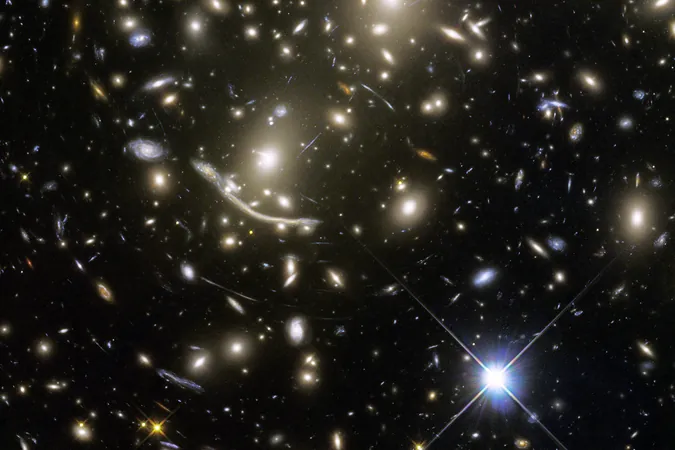
Astronomers Unveil 44 Ancient Stars Using Gravitational Lensing; A New Era of Discovery Awaits!
2025-01-08
Author: Li
In a groundbreaking discovery, astronomers have identified 44 ancient stars within the distant Dragon Arc galaxy, employing a fascinating technique known as gravitational lensing. This astrophysical phenomenon occurs when massive objects, like galaxies or galaxy clusters, bend the path of light from more distant stars, akin to how a glass lens focuses light.
Astrophysicist McCleary elaborates on this concept using the analogy of a large, stretched rubber sheet. When a heavy object is placed on this sheet, it creates a dip or distortion, impacting how smaller objects—imagine marbles—move across its surface. “That’s exactly what’s happening but with light rays instead of marbles,” McCleary explains. This distortion allows astronomers to observe stars that would otherwise be too faint or far away to detect.
Historically, astronomers have been able to observe individual stars within our Milky Way and adjacent galaxies like Andromeda. Yet, galaxies beyond our immediate cosmic vicinity have posed a challenge due to their vast distances. The recent discovery changed the game; utilizing the gravitational lensing from the galaxy cluster Abell 370, astronomers effectively turned the cluster into a gigantic magnifying glass.
Interestingly, a double layer of gravitational lensing was at play during this observation. Alongside the massive galaxy cluster, free-floating stars that had been dislodged by gravitational interactions also contributed a phenomenon known as microlensing. When these smaller stars drifted in front of the distant objects, they created additional magnification, allowing researchers to observe individual stars at the edge of the Dragon Arc galaxy’s disc.
This double lensing effect isn't entirely new; however, past attempts had only led to the identification of seven individual stars. The recent discovery magnifies the potential for investigation and opens up a new frontier for astrophysicists seeking insights into the universe’s history.
McCleary emphasizes the significance of this finding not only for the technology utilized, particularly the James Webb Space Telescope (JWST), but for its potential to reveal even more secrets of the cosmos. “This discovery validates new observational techniques. I expect many research teams will analyze existing JWST data looking for other hidden stars,” he stated. The number of detected stars like these could escalate rapidly, with hundreds potentially found in various clusters in the near future.
In a universe brimming with mysteries, this discovery serves as a thrilling reminder of what lies beyond our observable reach, igniting excitement in the scientific community and reminding us of the ever-evolving nature of astrophysical studies. What's next for astronomers as they peer deeper into the cosmos? The possibilities are endless!

 Brasil (PT)
Brasil (PT)
 Canada (EN)
Canada (EN)
 Chile (ES)
Chile (ES)
 Česko (CS)
Česko (CS)
 대한민국 (KO)
대한민국 (KO)
 España (ES)
España (ES)
 France (FR)
France (FR)
 Hong Kong (EN)
Hong Kong (EN)
 Italia (IT)
Italia (IT)
 日本 (JA)
日本 (JA)
 Magyarország (HU)
Magyarország (HU)
 Norge (NO)
Norge (NO)
 Polska (PL)
Polska (PL)
 Schweiz (DE)
Schweiz (DE)
 Singapore (EN)
Singapore (EN)
 Sverige (SV)
Sverige (SV)
 Suomi (FI)
Suomi (FI)
 Türkiye (TR)
Türkiye (TR)
 الإمارات العربية المتحدة (AR)
الإمارات العربية المتحدة (AR)